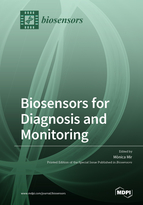Biosensors for Diagnosis and Monitoring
A special issue of Biosensors (ISSN 2079-6374). This special issue belongs to the section "Biosensors and Healthcare".
Deadline for manuscript submissions: closed (31 January 2022) | Viewed by 87007
Special Issue Editor
Interests: biosensors; electrochemistry; implantable sensors; sensors integrations on chip; organ on a chip; aptamers; ion-selective sensors; nanotechnology; point-of-care devices (POC)
Special Issues, Collections and Topics in MDPI journals
Special Issue Information
Dear Colleagues,
Biosensor technologies have gained considerable interest in recent decades, and especially this year, due to the health alert caused by a new virus. More and more sensitive and selective biosensors are being required with a fast, low-cost response to our day-to-day lives, increasing the applications and market for this technology.
The Special Issue “Biosensors for Diagnosis and Monitoring” is dedicated to all areas of research related to biosensor technologies in a broad definition, including but not limited to the development of biosensor interfaces, signal reading mechanisms, integrated biosensors in lateral flow, biosensors in lab on a chip, point-of-care devices, portable sensors, wearable sensors, implantable sensors and sensors integrated in organs on chip platforms, etc.
The Special Issue is open to a wide range of biosensor applications, such as in medical diagnosis, environmental monitoring, food industry, defense and security, biomedical research, and agriculture. The Special Issue will consist of original research articles and reviews.
We look forward to your participation in this Special Issue.
Dr. Mònica Mir
Guest Editor
Manuscript Submission Information
Manuscripts should be submitted online at www.mdpi.com by registering and logging in to this website. Once you are registered, click here to go to the submission form. Manuscripts can be submitted until the deadline. All submissions that pass pre-check are peer-reviewed. Accepted papers will be published continuously in the journal (as soon as accepted) and will be listed together on the special issue website. Research articles, review articles as well as short communications are invited. For planned papers, a title and short abstract (about 100 words) can be sent to the Editorial Office for announcement on this website.
Submitted manuscripts should not have been published previously, nor be under consideration for publication elsewhere (except conference proceedings papers). All manuscripts are thoroughly refereed through a single-blind peer-review process. A guide for authors and other relevant information for submission of manuscripts is available on the Instructions for Authors page. Biosensors is an international peer-reviewed open access monthly journal published by MDPI.
Please visit the Instructions for Authors page before submitting a manuscript. The Article Processing Charge (APC) for publication in this open access journal is 2700 CHF (Swiss Francs). Submitted papers should be well formatted and use good English. Authors may use MDPI's English editing service prior to publication or during author revisions.
Keywords
- biosensor interface
- transductors
- electrochemical biosensors
- optical biosensors
- aptamers-based biosensors
- enzyme-based biosensors
- DNA-based biosensors
- immunosensors
- lateral flow
- biosensors in lab on a chip (LOC)
- point-of-care devices (POC)
- portable sensors
- in vivo biosensors
- wearable sensors
- implantable sensors
- sensors integrated in organs on chip (OoC)
- Diagnosis
- environmental biosensors
- food biosensors
- biomedical biosensors
- security biosensors
- agriculture biosensors







